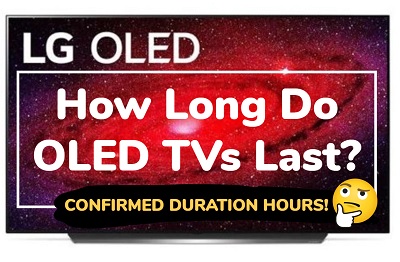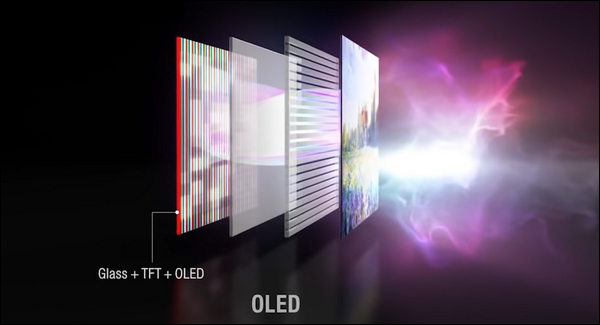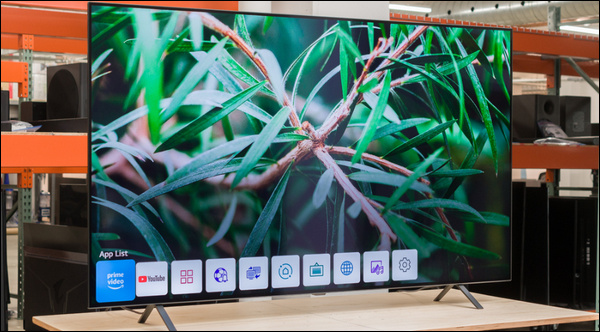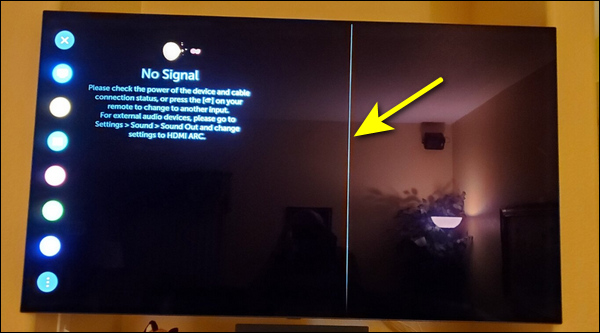In the world of television, OLED TVs are in a class of their own and represent the pinnacle of modern TV technology. How long do they last, and how do they compare in durability to QLED and traditional LED TVs? These are all the questions you will find answers to in this guide.

OLED TVs use a display technology that is based on the characteristics of organic light-emitting diodes (OLED), and which has a variety of advantages over traditional LCD-LED display technologies, including better brightness, more efficiency, thinner screens, and higher contrast.
When it comes to televisions in general, one of the most pressing concerns for customers is the lifespan. So, if you are wondering, “how long do OLED TVs last?”, you are on the right page.
In this article, I will answer this question as well as cover other key aspects of OLED TVs.
Contents
- 1 Advantages of OLED Over Other Display Technologies
- 2 OLED Lifespan Hours: How Long Do OLED TVs Last?
- 3 LG OLED TV Lifespan: What to Expect From the Best Brand?
- 4 What Factors Influence the Lifespan of OLED TVs
- 5 Comparing Lifespans: OLED VS Other Display Technologies
- 6 3 Tips for Extending the Life of an OLED TV
- 7 Common Signs of an OLED TV Nearing Its End of Life
Advantages of OLED Over Other Display Technologies
- OLED displays have superior image quality compared to other types, such as LCD and LED: This is due to different reasons, including their ability to produce deep & dark blacks, which is one of the most important factors in achieving excellent image quality, especially in dark rooms.
- When it comes to response time, OLED is on another level compared to other display technologies. OLED displays offer the fastest response time, which results in smoother animations/transitions between frames.
- OLED displays, in general, are more energy efficient than LCD-LED TVs. However, this may not be the case when displaying brighter white images.
- OLED displays are typically thinner than other display technologies due to the small size of their diodes.

OLED Lifespan Hours: How Long Do OLED TVs Last?
When speaking about how many hours or even years your OLED TV will last, you will see many numbers floating around the web on blogs, forums, etc. However, these are just speculations that we can’t rely on since they are NOT supported by reliable sources.
The only source that appears to be reliable and trustworthy is the US Department of Energy.
According to a 2016 report from the US Department of Energy, the estimated lifespans of OLED displays are 10,000 hours at 100% brightness and 40,000 hours at 25% — Yes, the higher the brightness, the shorter the OLED lifespan.
LG OLED TV Lifespan: What to Expect From the Best Brand?
LG is the leading brand in OLED TV technology, so you cannot talk about OLED displays without mentioning LG.
LG has been manufacturing OLED TVs for many years, and its OLED displays have quickly become the most popular on the market. This is mostly because of the numerous features that set LG’s OLED TVs apart from those of other manufacturers.
For that reason, let’s discuss the lifespan of LG OLED TVs separately.

LG began manufacturing OLED TVs in 2013, and the expected lifespan of the models around that time was 36,000 hours.
In 2016, the Vice president of LG Electronics at that time reported that the lifespan of OLED TVs has extended to 100,000 hours.
Since there are many factors that can affect the OLED TV lifespan, this value will sure vary with different users.
What Factors Influence the Lifespan of OLED TVs
The lifetime of an OLED TV is mostly determined by four factors:
- Usage Habits: For most of us, it’s easy to forget that our usage habits can have a major impact on the lifespan of our electronic devices. For example, In the case of your OLED TV, if you watch it at maximum brightness levels consistently for extended periods of time, then its lifespan will be shorter than average.
- Quality of the Display: High-quality displays typically have better materials and manufacturing processes, which means a longer lifespan than low-quality displays.
- Environmental Conditions: This includes high temperatures, extreme humidity, dust accumulation, and so on, which has been proven that OLED TVs are quite sensitive to these environmental conditions.
- Power fluctuation: Also known as voltage fluctuation, can have a significant impact on the lifespan of your OLED TV, especially if you reside in a location where unstable electricity is the usual.
Comparing Lifespans: OLED VS Other Display Technologies
OLED vs LED: Do OLED TVs last longer than LED?
When it comes to lifespans, LED TVs last longer than OLED TVs by far. LED TVs have been around for a significant amount of time and have proven that they can last up to 100,000 hours, as opposed to OLED TVs, which have proven a lifespan of up to 40,000 hours.
OLED vs QLED Lifespan: Which is Longer?
If longevity is the thing that matters to you, then let me tell you that QLED TVs tend to have a longer lifespan than OLED TVs. According to Samsung, the leading brand in QLED TV technology, QLED TVs have an average lifespan of 7 to 10 years with normal use.
3 Tips for Extending the Life of an OLED TV
- Avoid Excessive Brightness Settings: to increase the lifespan of OLED Televisions, it is recommended that users avoid high levels of brightness settings, and instead set the brightness level at about 40%.
- Make sure the environmental conditions are optimum: You should keep the TV in a cool, dry place that is away from direct sunlight and has good ventilation.
- Clean the Screen Regularly: Clean off dust and debris particles that accumulate on the OLED’s surface using a soft cloth at least once every week.
Common Signs of an OLED TV Nearing Its End of Life
Display Issues: Screen dimming, fading, and blinking are “good” signs to start with. Also, if you see blurring effects in some screen areas, it’s time to replace your OLED TV. Additional signs include dead pixels and burn-in edging. Oh, let’s not forget about the vertical lines as well.

Poor Color Quality: This doesn’t need to be explained. I mean we all know that over time, the image quality of your TV will degrade due to prolonged wear & tear. When this becomes obvious, it’s likely time for an upgrade.
If you have issues with your LG TV, check out these troubleshooting guides.
Conclusion
Since OLED TVs represent the cutting edge of television technology, combined with the features that OLED offers which leave traditional LCD-based displays in the dust; OLED displays are becoming more popular and widespread.
As a result, greater advancements in the field of OLED technology are expected, which means not only higher-quality images, but also longer lifespans when compared to other existing display technologies.
